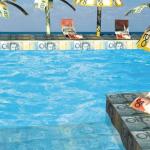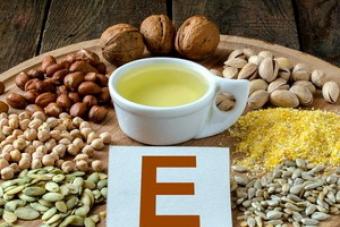Distinctive features in feeding guppy fry
Guppies are viviparous fish, therefore, after the female spawns, newborn fry will begin to look for food, moving around the entire aquarium. Particular attention should be paid to them in the first week of their existence. Most of the successful breeding of guppies depends on competent and proper feeding. It is worth waiting for healthy and beautiful fish only if they are fed regularly.
After the birth of offspring, female guppies are able to eat their cubs, since they are deprived of maternal instinct, and the size of the fry does not exceed 3 mm. To keep them safe, the fry should be transplanted into another vessel immediately after the end of childbirth.
Feeding fry is different from feeding adult fish. For guppy fry, the process of eating 5-6 times daily is characteristic. Feed is poured as much as they are able to eat at a time, otherwise it will fall to the bottom of the vessel and the life of the fry will be in danger: the water will be saturated with nitrogen, and this is detrimental to guppies. The water in the tank with small cubs should be changed daily from the aquarium in which their parents live.
Feeding for guppy fry is a simple process, since their food is no different from the food of adult fish. The only caveat is the size of the food, the mouths of babies are small, so it must be crushed into pollen.
For the rapid growth and development of guppies, it is necessary to keep the lighting in the aquarium open for several days.
Feed varieties
Let's take a closer look at how to feed guppy fry in the first days of their life.

The best option is live food, namely:

At home, you can make a substitute for live food yourself: scrambled eggs, egg yolk, yogurt or other food that the fry willingly eat.
It is impossible to choose one hundred percent the best food among all types, since each of them has its pros and cons. The most important thing is to try to feed the guppies systematically, balanced and moderately.
Feed commercial enterprises

Special food for fish is sold at any pet store. The most common are dry food and solutions from the Tetra brand of German manufacturers. The paste of such a company is dense and includes the following composition:
- fish liver;
- beef liver;
- yolk;
- artemia;
- mosquito larvae;
- milling of germinated wheat and other products.
To prevent infection, the production of such products uses ultraviolet irradiation of feed.
Food of natural origin
According to many guppy lovers, live food is the starting food for fry, since such nutrition is typical in the natural environment.

After the birth of guppies, they are given “live dust”, and after a week, you can feed them in the form of rotifers, brine shrimp, crushed bloodworms or microworms.
Aquarists have long studied the technique of self-feeding guppy fry from a variety of foods. How to feed fry at home, consider below:
- Egg food - boil the egg, remove the yolk and rub it on a grater, add to a container of water. The mixture must be stirred until a homogeneous consistency, and then added to the aquarium with a pipette.
- Milk feed - a container of milk is placed in a pot of boiled water. After evaporation, the milk powder can be given to guppies.
It is worth noting that the grated yolk and milk powder are not a complete food, they should be added with other top dressings.
- Live food - this method consists in breeding a microworm, fry love to eat it. To dilute this protein, you need to mix cornmeal and water (should resemble sour cream), add a quarter of a teaspoon of yeast. Put a microworm in this porridge (you can take it from fish lovers or find it on the street in wet fallen leaves). After a few days, it will multiply and it will be possible to feed the fry with it.
- Plant food - the diet of guppy fry should be saturated with plant foods. It includes zooplankton - living microorganisms and phytoplankton, expressed in small algae. In the first days of their existence, fry feed on such vegetation with pleasure, each of its grains varies from 0.02 mm to 1 mm.
Phytoplankton is grown quite simply: water from the aquarium is poured into a jar and placed on the windowsill under the falling sun. Photosynthesis takes place and algae begin to grow. After a few days, the water will turn green and you can add it little by little to the vessel with the guppy fry.
Any aquarist wants to raise a full-fledged healthy offspring of fish. The basis of this is the correct balanced nutrition of fry. It is during the initial period of development that the immunity of fish is laid down and their further growth will depend on the quality of nutrition of the fry. The same applies to guppy fry. It is the guppy babies that are usually the first fish that are bred by beginners.
Starter feed
Guppies are viviparous fish. As a rule, they are born without a yolk sac and need quality nutrition from the very first day.
Starter food is very important for baby guppies. The first week of feeding is the most important and is responsible for the growth rate and health of the fry. Usually, if during this period the guppy fry ate normally, then in the future, there are no problems.
After spawning, you need to transfer the female to a common aquarium and create a feeling of constant satiety in the fry. As a starter food for guppies, it is best to use brine shrimp nauplii. It is necessary to feed the fry 5-6 times a day a little bit and at the same time do not overfeed. You also need to monitor the quality of the water and clean up the leftover feed in time.
Live food
It is possible and necessary to feed live food from the second week of life. Perfect for this:
- cut bloodworm;
- cut pipe maker;
- Cyclops;
- artemia;
Live foods contain a high protein content. Thanks to him, guppy fry very quickly grow in growth and grow up healthy.
Dry food
On sale there are specialized granular feeds for fry. They cannot be discounted.
The benefits of dry food
- excellent solution in terms of diversity;
- very convenient when in a hurry;
- contain vitamins and minerals not found in live foods.
But do not overdo it with dry food. If you feed guppy fry only with them, then the fry can be tightened and grow for a very long time.
Guppies or, as aquarists affectionately call this type of fish - "guppies", the most frequent inhabitants of aquariums. They are bred by both beginners and already experienced aquarists, experimenting with crossing different individuals, deducing new types of the most exotic colors. For breeding guppies, no special conditions are needed, they are very unpretentious, and for their safe keeping, it is enough just to maintain a temperature of about 25 C.
But the main thing that made them so popular is that they do not spawn like most aquarium inhabitants, but give birth to already living fry, which almost immediately begin to move and look for food.
Guppies are peaceful in nature and get along well with other non-aggressive types of aquarium fish. For breeding, usually the female is placed in a separate aquarium, volume which approximately 30 l. This is ideal, but if one is not at hand, then an ordinary three-liter jar may be suitable, although it is much more difficult to provide the required conditions for good growth of young animals in it. The readiness of the female to give birth is assessed by the dark anal spot. On the eve of childbirth, it becomes very dark. Immediately after giving birth, the female must be returned to the aquarium, because this breed has a tendency to eat its offspring.
Fry need to provide certain conditions, in particular water temperature should be 25-30 C. If the temperature is lower, growth retardation and incorrect formation of many organs of the fish are possible.
If the guppy fry are divorced in an aquarium that contains other fish, then in order for at least some of them to survive, you need to plant as much vegetation as possible, which will serve as shelter for them. But this is the last resort. To save the fry, they need catch and place in a separate vessel.
In order for the fry to grow beautiful and healthy, in addition to the temperature regime, you need to follow a few more simple rules. This is the purity of water, lighting and feeding. Filter must work constantly, and his sponge should be washed every 5-7 days. Aeration also obligatory and should work continuously.
An aquarium with newly born fry needs longer lighting, which gradually decreases. Cleaning or water siphoning should become a daily routine. It is also necessary daily water change. Each time you need to change at least 20 percent of the water, maybe a little more. You need to add only clean water that has settled for about a day.
Guppy fry are distinguished by good mobility. If they behave inhibited, then this is a signal that not everything is safe in their underwater world. It's most likely a water problem. You need to look at the thermometer - the ideal temperature for fry is 28 C. If everything is in order with this, then you need to replace the water.
Feeding
Guppies have a very good appetite, but feeding them at different periods of life is very different. Fry are supposed to be fed five times a day and make sure that all the food is eaten. Leftover food can precipitate out, polluting the water. Many aquarists feed fry dry food. Although this is not an ideal option, it has every right to life, however, the addition of vitamin D is necessary.
Now pet stores sell special starter foods for fry and this is ideal because it contains all the necessary elements. In addition, this food is safe, as it is necessarily treated with ultraviolet rays.
If for some reason it is not possible to purchase branded food, then can be fed:
- curdled milk scalded with boiling water;
- chicken yolk;
- scrambled eggs;
- dry milk;
- cheese.
These feeds, like dry ones, cannot be used constantly; it is possible not only to reduce the growth rate, but in some cases, the death of the fish. A good food for small guppies is fresh brine shrimp on it recommend feeding fry most aquarists up to a month old.
Outcome
In short, keeping guppy fry is a simple matter, you just need to remember simple rules:
- Replant adult fish so that they do not eat fry.
- If guppy fry do not eat during feeding, there may be problems with the quality of the water in the aquarium.
- The vast majority of problems are related to water quality or insufficient cleaning of the aquarium itself: collecting leftover food from the bottom, changing the water and cleaning the filter.

Guppies are aquarium fish, quite unpretentious. Precisely because it is not difficult to keep them, breeders, starting with beginners, breed them in their home "reservoirs". What else is attractive guppies? They have unusually beautiful bright colors, they are mobile, so the presence of these fish will decorate any aquarium.
Guppy - viviparous fish: formed already in the tummy of the guppy mother. They are born almost fully formed and capable of independent living. Small guppies are called fry. After birth, they are placed in a separate aquarium.
It is after birth that aquarists have an important question : what to feed fry guppies.
Guppy nutritional features
Small guppies need to be fed differently than adults. If the big ones are fed twice a day, then the kids are fed 5 to 6 times. Feed at one time give so much to eat immediately. Otherwise, it will settle to the bottom and create life-threatening conditions for the fry in the aquarium: in the water a lot of nitrogen is produced, which will lead to the death of the offspring of guppies. In addition, water changes should be daily. It should be taken only from the aquarium where dad and mom swim.
It is not necessary to say that feeding is an extremely difficult issue, since the fry are ready to eat food that is also fed to adults. The only question is the size of this food: it should be much smaller, since the mouths of guppy fry are very small. If you feed dry food, then it needs to be kneaded between your fingers so that it turns into dust.
You can choose another option: purchase a special food (Tetra MicroMin or Sera Micropan) intended for feeding fry. Both foods are balanced, so you don't have to add anything: your fry will receive a complete nutrition in accordance with their age.
There is also substitute MicroMin, which contains all the vitamins that are required for guppies in the first days of life.
In order for the fry to grow full-fledged, they need to be fed carefully. You need to be especially attentive to them in the first week. In addition, the light must not be turned off even for a minute, otherwise the fry may die.
How to feed guppy fry at first?
How you feed your pets in the first five days will depend on their full growth and development. Don't forget to feed them on time. Fish must find food at any time.
Better use live food:
- It can be living dust (a "ciliate shoe" is suitable, but you can feed it for three or five days).
- microworms that you have grown yourself on chopped carrots, or purchased at a pet store,
- nauplia, cortemia, rotifers (grind!).
- Dry food is also appropriate, but it should be used for feeding fry only once a week.
For the first seven days, food is given 4 to 5 times daily. In the second week, four meals a day will be enough. From now on, you can add crushed bloodworm, tubifex, nematode, but this complementary food can be given only once a week.
The fry eat well live food substitutes, which you can cook yourself at home: chicken yolk, scrambled eggs, yogurt and other food.
How to prepare live food substitutes?

It is advisable not to feed the fry with dry food during the first month. The thing is, you can't fill it properly. Excess food "rots", forming a film on the water area of the aquarium. She doesn't let air through. In addition, small guppies cannot swallow such rough food.
What else you need to know about feeding
 Question, what to feed guppy fry, is important in the future. After two months, you can feed the tubifex, daphnia, cyclops, thread algae. Plant foods won't hurt. From ready-made compositions, use Gordon's mixture. From the first days you need to monitor the balance of food. If this is not done, then no quality nutrition will further help in the proper development of fry. It will not be possible to obtain a bright color, and the collapse of the tail will not meet the desired characteristics.
Question, what to feed guppy fry, is important in the future. After two months, you can feed the tubifex, daphnia, cyclops, thread algae. Plant foods won't hurt. From ready-made compositions, use Gordon's mixture. From the first days you need to monitor the balance of food. If this is not done, then no quality nutrition will further help in the proper development of fry. It will not be possible to obtain a bright color, and the collapse of the tail will not meet the desired characteristics.
Need to feed guppies according to weight:
- From birth and during the first 14 days, food is plentiful, 50-70% more weight.
- From the 15th day to the age of two months - from 80 to 100%
- After two months - about 30%.
- When the guppies are divided by sex, you need to feed even less - about 15% of the weight.
- Those fry that are left as producers should be fed with caution, significantly reducing portions: feed is only 3 to 5%.
You can transplant grown fry into a common aquarium after three months. Adult guppies will not be able to harm them.
Many beginner aquarists are interested in growing guppy fry. It is worth starting to take care of the babies of one of the most popular fish even before they are born.
Training
A pregnant female guppy on the eve of childbirth must be isolated from other fish. Further specific measures will help keep future offspring safe and sound.

Before giving birth, the female's belly becomes large and a black spot appears at the anal fin.
- It is necessary to prepare a separate container, with a volume of 20 - 40 liters for jigging a pregnant female, pour clean, settled water and the one that was in the general aquarium in a ratio of 2: 3.
- Prepare the lighting element, water filter and compressor for aeration.
- Put a little soil on the bottom of the jigging aquarium and fix algae in it, preferably with tall stems and leaves.
The birth of fry
So, the “kindergarten” for keeping kids is ready. For childbirth, the female needs to create optimal conditions: the water temperature should be 26 - 28 degrees (in the first two weeks), aeration and lighting should be maintained constantly.
Guppies are viviparous fish. Babies are born and immediately rush to the bottom or into thickets of vegetation. This makes them do the instinct of self-preservation. Otherwise, Guppy fry run the risk of being eaten by their own mother. Maternal instinct is not inherent in this type of fish.
A primiparous female can give birth to at least 20 fry. In the future, their number can reach 180 pieces. Although the size of newborns is only 3 - 5 mm, caring for guppy fry is very simple.
If everything went as it should, the birth was not premature, the yolk sac should not be visible in the babies. If it is, then the fish were born too early and will not be viable.
First days

This is what a newborn baby looks like.
- Feeding. Give food to babies in the first few days should be 4 - 5 times a day in small portions. It is important that they have a rounded abdomen, the fry should always be full.
- What to feed. The diet of Guppy fry is as follows: a special store composition, Artemia larvae or a boiled egg yolk mixed with water. The main thing is that the food must be sufficiently crushed, otherwise the fish will not be able to swallow it.
- Feed volume. After the fry have eaten, the remains must be carefully removed from the aquarium. Feed should not be constantly on the surface of the water.
- Temperature regime for guppies. The first 14 days it is maintained at around 28 degrees, after a week it can be reduced to 26, after the next - to 24
- The composition of water. For the comfort of the fish, it will be very useful to replace the water daily, about a third, with a new portion (previously settled for 2 - 3 days)
In this way, you can grow Guppy fry in a jar, in a separate aquarium or any other container.
Age over 2 weeks

Growing gupyats begin to acquire color.
After 14 days and up to 2 months of age, the following actions are carried out:
- 2 meals a day. You can start tracking sex characteristics
- It is important to ensure that the Guppy fry eat all the food and collect leftovers if necessary (for the cleanliness of the aquarium)
- The duration of the light period can be reduced to 8 - 10 hours per day
- Food should be given daily, but every week to take a daily break. During this period, the digestive system of the fish will be cleansed, so their health will become excellent.
- After 4 - 5 weeks, crushed bloodworm or tubifex can already be added to Guppy food
From the "kindergarten" grown up babies can be released into the general aquarium when they reach a size of 2.5 - 3 cm.
Usually "mature" fry become 3 months later. If birth control or selection is underway, females and males should be separated before entering “adulthood”.
You can lower the water temperature in the aquarium to 18 degrees (in winter), this will avoid fertilization. Guppy females will benefit from a break in childbirth to restore strength and health.
The process of breeding and selection can be continued to be controlled: in the future, select the brightest males, plant them with females and get beautiful offspring.
Sex differences

The photo highlights the genital organ of male guppies - gonopodia.
Male Guppy fish acquire the first difference early - they form an anal fin - gonopodium. It stretches along the body and resembles a tube, functions as a sexual organ. Growing up, male Guppy fry are painted in different colors.
Their growth stops after 3 months, but a change in color begins to appear. It becomes brighter, juicier. The fins and tails also begin to color quickly and take on a curvaceous shape.
Female Guppies usually only grow in size. They form a round abdomen with a dark spot at the anal fin - where the caviar will be located in the future. Females acquire their own color, implicit, with various shades: yellow, blue, olive.
If favorable conditions are created, Guppies will breed every month. Females often bear offspring several times after one fertilization.
Shared Aquarium

For growing goupes in a common aquarium, you can use special jigger.
It happens that childbirth occurs uncontrollably. The female Guppy brings fry in the general aquarium. Then natural selection comes into force, many fry die. The slowest and weakest will be eaten by adult fish, the fastest will be able to survive. If there is no goal to specifically breed Guppy fish, then this option is acceptable.
If it is necessary to transplant fry, you need to catch them from the general aquarium using a glass and deposit them separately. For all those who can be saved, continue to carry out proper care.
Guppy diseases
Signs of diseases of various kinds in Guppy:
- Guppies don't eat for several days
- Tails stick together (or shrink in a horizontal plane)
- Fins split or split
- The body is deformed, the color has become dull
- Fish behave strangely: “rub” against stones and algae, lose coordination
In these and other cases, a number of measures are required to cure Guppy: changing food, changing the parameters of the water composition, or adding special preparations to the aquarium.
Conclusion
Guppies are the best option for an aquarist taking their "first steps". Fish are unpretentious, there is nothing difficult in caring for them. This applies to both adults and fry.
Even if Guppies are not specifically monitored and spontaneous reproduction is allowed, this problem will be solved by itself by means of biocenosis and natural selection inside the aquarium.





